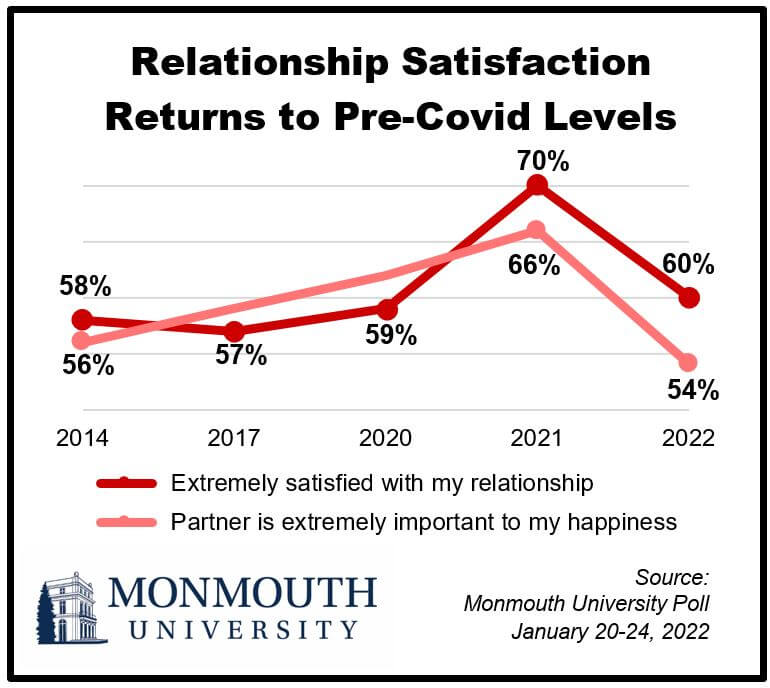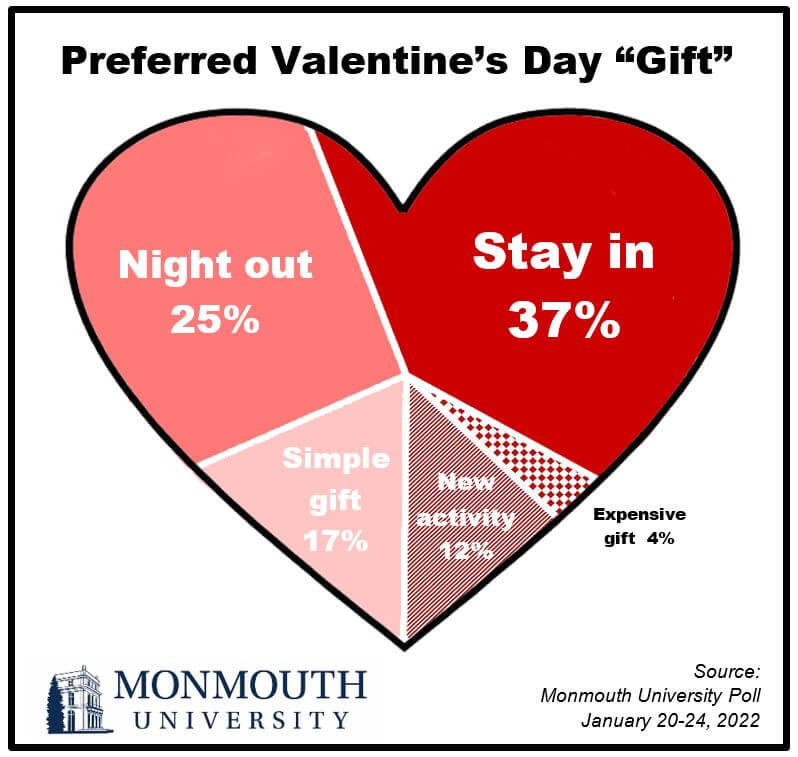West Long Branch, NJ – Relationship satisfaction in the United States remains high, but has returned to its pre-Covid levels after experiencing an upward bump last year. About 3 in 4 Americans who have a romantic partner say their relationship is about the same as it was before the pandemic. The national Monmouth (“Mon-muth”) University Poll also finds that more Americans intend to go out for Valentine’s Day this year than last year, but the popularity of “dinner and a show” as the preferred Valentine’s gift has declined from pre-Covid days.
Among Americans who are currently married, living with a partner, or otherwise in a romantic relationship, 9 in 10 are clearly satisfied with their current relationship. This finding has been consistent since Monmouth started asking this question more than seven years ago. The number of people who are extremely satisfied with their relationship currently stands at 60% – which is down from 70% who felt this way one year ago, but is in line with the range (57%-59%) for this sentiment between 2014 and 2020.

Just over half (54%) say their partner is extremely important to their overall happiness, which is down from 2021 (66%) but in line with 2014’s poll (56%). This return to pre-Covid attitudes has occurred among every demographic group after last year’s bump. At the same time, those who are in a married partnership (64% extremely satisfied, 59% extremely important) continue to be more content with their relationship than those who are unmarried (46% extremely satisfied, 39% extremely important). More men (60%) than women (48%) say their partner is extremely important to their own happiness, but women (59%) and men (60%) are equally likely to be extremely satisfied with their current relationship.
“The pandemic gave relationships an unexpected boost by forcing partners to rely on each other more, which allowed couples to better appreciate what they had. A year later, as we get back into our old routines, it shifts our attention away from our relationship which undermines satisfaction,” said Dr. Gary Lewandowski, professor of psychology at Monmouth University and author of Stronger Than You Think: The 10 Blind Spots That Undermine Your Relationship…and How to See Past Them.
Overall, about 3 in 4 (74%) of those polled say the state of their relationship is about the same as it was prior to the Covid outbreak. Another 16% say their relationship has improved and 7% say it has become worse. One year ago, 68% said their relationship was the same and 21% said it was better since the start of the pandemic, while 9% said it was worse. The current results are more in line with attitudes recorded in the first few months of the outbreak (May 2020), when 74% said their relationship had not changed, 17% said it was better and 5% said it was worse. Among married adults in the current poll, 15% say their relationship has gotten better since the Covid outbreak started and 7% say it has gotten worse. Among unmarried adults in a relationship, 17% say it has gotten better and 12% say it has gotten worse. These marital status differences are not statistically significant.
“The good news is that most couples continue to report no pandemic-induced change to their relationship, or improvement, with very few noting declines. This once again shows just how resilient relationships are, even in the face of significant challenges and stress,” said Lewandowski.
The Monmouth University Poll also asked those currently in a relationship about their Valentine’s Day plans this year. More than half say they will do something special, which is similar to 2021. However, the number who say they will go out for dinner or some other event rather than stay in to celebrate has increased from 19% last year to 31% this year. While this number has risen, it is still off pre-pandemic levels. When Monmouth asked a similar question in 2014, a slightly higher 42% said that they and their partner usually go out for Valentine’s Day. The current results include similar numbers of those who are married (30%) and unmarried (33%) saying they will venture out to celebrate this year.
If those in a relationship had to choose just one Valentine’s Day gift, though, just 1-in-4 (25%) say a night out would make them the happiest. This is down from 2014, when 40% selected a night out such as dinner or a show as their most desired Valentine’s present from among five different types of gifts. The current result is also down from 50% who preferred a night out in last year’s poll when presented with a hypothetical situation of the Covid outbreak not being a factor. Compared to pre-Covid levels, preference for a night out on February 14 has dropped more among married adults (from 42% in 2014 to 25% now) than among unmarried ones (from 33% to 25%).

In fact, spending time together at home doing a favorite activity (37%) is now the most desired type of Valentine’s Day gift among those asked about in the poll, which is a marked increase in its popularity since 2014 (26%). Other types of gifts remain about as popular as they were a little over seven years ago, including a simple gift like flowers or candy (17%), a new activity such as taking a class (12%), or an expensive gift like jewelry or electronics (4%). These latter results are very similar to the 2014 poll results.
“The pandemic has shifted how we think of romantic Valentine’s Day activities. While many couples may prefer a night on the town if Covid wasn’t a factor, it appears that they are adjusting their expectations in light of the new reality,” said Lewandowski.
There is an interesting side note on Valentine’s gift preference. Only 43% of those who say they plan to go out this Valentine’s Day actually choose a night out as the type of gift that would make them happiest. This is equally true regardless of marital status.
In general, there are few significant differences by marital status as to which types of Valentine’s gifts would make Americans happiest, but there are some notable gender differences. The popularity of having a night out dropped by similar levels among both sexes, but that also means men (33%) remain more likely than women (18%) to pick it as the Valentine’s gift that would make them happiest. The top choice for both sexes is staying home, which nominally edges a night out among men (35%) and is preferred by a larger margin among women (39%). Women (22%) are also somewhat more likely than men (13%) to say a simple gift like flowers or candy would make them happiest on Valentine’s Day.
“Couples’ thoughts about Valentine’s gifts are a reminder of what matters most in relationships: spending time together, whether it is going out or staying home. It can be easy to equate showing love with buying presents. But, for relationships to really flourish, what they actually need is more shared experiences,” said Lewandowski.
In other poll findings, a majority (55%) of Americans in a relationship usually receive a card from their partner on Valentine’s Day. And 8 in 10 of those who get a card say their partner adds a personalized message to the pre-printed sentiment. This poll result is consistent among both married and unmarried adults as well as among both women and men.
The Monmouth University Poll was conducted by telephone from January 20 to 24, 2022 with 794 adults in the United States. The results in this release are based on 565 individuals who are currently in a relationship – of which 76% are married, 12% are living with a partner, and 12% are in a non-cohabitating romantic relationship – and have a +/- 4.1 percentage point sampling margin of error. The poll was conducted by the Monmouth University Polling Institute in West Long Branch, NJ.
QUESTIONS AND RESULTS
(* Some columns may not add to 100% due to rounding.)
[Q1-35 previously released.]
36.Which of the following best describes you: married, living with a partner, never been married, widowed, divorced, or separated? [If NEVER MARRIED/WIDOWED/DIVORCED: Are you currently in a romantic relationship with someone?]
| TREND: | Jan. 2022 | Jan. 2021 | May 2020 | Jan. 2017 | Dec. 2014 |
| Married | 50% | 51% | 48% | 50% | 52% |
| Living together | 8% | 9% | 10% | 10% | 7% |
| In a relationship | 8% | 9% | 8% | 10% | 11% |
| No relationship | 32% | 31% | 32% | 29% | 28% |
| (VOL) No answer | 2% | 1% | 1% | 1% | 1% |
| (n) | (794) | (809) | (808) | (801) | (1,008) |
[The following questions were asked only of those currently in a relationship; n=565, m.o.e.=+/-4.1%]
37.How satisfied are you with your current relationship – extremely, very, somewhat, not too, or not at all satisfied?
| TREND: | Jan. 2022 | Jan. 2021 | May 2020 | Jan. 2017 | Dec. 2014 |
| Extremely satisfied | 60% | 70% | 59% | 57% | 58% |
| Very satisfied | 30% | 22% | 33% | 31% | 30% |
| Somewhat satisfied | 5% | 6% | 4% | 9% | 8% |
| Not too satisfied | 2% | 0% | 0% | 1% | 2% |
| Not at all satisfied | 2% | 1% | 1% | 1% | 2% |
| (VOL) Don’t know | 2% | 1% | 2% | 1% | 1% |
| (n) | (565) | (551) | (556) | (566) | (749) |
38.And how important is your partner to your overall happiness – extremely, very, somewhat, not too, or not at all important?
| TREND: | Jan. 2022 | Jan. 2021 | Dec. 2014 |
| Extremely important | 54% | 66% | 56% |
| Very important | 35% | 26% | 33% |
| Somewhat important | 7% | 7% | 8% |
| Not too important | 1% | 1% | 1% |
| Not at all important | 2% | 1% | 1% |
| (VOL) Don’t know | 1% | 0% | 1% |
| (n) | (565) | (551) | (749) |
39.Would you say your romantic relationship has gotten better or worse since the Covid outbreak started two years ago, or is it about the same? [Is that a lot or a little better/worse?]
| TREND: | Jan. 2022 | Jan. 2021* | May 2020* |
| A lot better | 11% | 13% | 10% |
| A little better | 5% | 8% | 7% |
| About the same | 74% | 68% | 74% |
| A little worse | 4% | 6% | 4% |
| A lot worse | 3% | 3% | 1% |
| (VOL) Relationship started after outbreak | 1% | 1% | n/a |
| (VOL) Don’t know | 2% | 1% | 4% |
| (n) | (565) | (551) | (556) |
* Jan. 2021: “since the coronavirus outbreak started last year” / May 2020: “since the coronavirus outbreak”
40.Looking ahead to Valentine’s Day next month, will you and your partner do anything special to mark the day? [If YES: Will you go out to dinner or some other event or will you stay in to celebrate the day?]
| Jan. 2022 | Jan. 2021 | |
| Yes, go out | 31% | 19% |
| Yes, stay in | 25% | 38% |
| No, nothing special | 39% | 39% |
| (VOL) Don’t know | 5% | 4% |
| (n) | (565) | (551) |
41.Does your partner usually give you a card for Valentine’s Day, or not? [If YES: Does your partner usually just sign the card alone or with love, or does your partner usually write an additional personal message to you in the card?]
| Jan. 2022 | |
| Yes, just signs it | 7% |
| Yes, additional personal message | 45% |
| Yes, don’t know how usually signed | 3% |
| No, doesn’t give a card | 45% |
| (n) | (565) |
42.If you had to choose just one Valentine’s Day gift, which of the following would make you the happiest – an expensive gift like jewelry or electronics, a simple gift like flowers or candy, having a night out such as dinner or a show, planning a new and interesting activity together such as taking a class, or spending some time together at home doing a favorite activity? [CHOICES WERE ROTATED]
| TREND: | Jan. 2022 | Jan. 2021* | Dec. 2014 |
| Expensive gift | 4% | 4% | 5% |
| Simple gift | 17% | 13% | 15% |
| Night out | 25% | 50% | 40% |
| New activity | 12% | 12% | 11% |
| Stay home | 37% | 19% | 26% |
| (VOL) Other | 1% | 1% | 2% |
| (VOL) Nothing/Don’t know | 5% | 2% | 2% |
| (n) | (565) | (551) | (749) |
* Jan. 2021 wording included the hypothetical: “…and the outbreak wasn’t a factor…”
METHODOLOGY
The Monmouth University Poll was sponsored and conducted by the Monmouth University Polling Institute from January 20 to 24, 2022 with a probability-based national random sample of 794 adults age 18 and older. This includes 267 contacted by a live interviewer on a landline telephone and 527 contacted by a live interviewer on a cell phone, in English. Telephone numbers were selected through a mix of random digit dialing and list-based sampling. Landline respondents were selected with a modified Troldahl-Carter youngest adult household screen. Interviewing services were provided by Braun Research, with sample obtained from Dynata (RDD, n=476), Aristotle (list, n=119) and a panel of prior Monmouth poll participants (n=199). Monmouth is responsible for all aspects of the survey design, data weighting and analysis. The full sample is weighted for region, age, education, gender and race based on US Census information (ACS 2018 one-year survey). The key results in this poll release are based on a subsample of 565 individuals who are currently in a relationship. For results based on this sample, one can say with 95% confidence that the error attributable to sampling has a maximum margin of plus or minus 4.1 percentage points (unadjusted for sample design). Sampling error can be larger for sub-groups (see table below). In addition to sampling error, one should bear in mind that question wording and practical difficulties in conducting surveys can introduce error or bias into the findings of opinion polls.
| DEMOGRAPHICS (weighted) | |
| ALL ADULTS | IN A RELATIONSHIP |
| Self-Reported | Self-Reported |
| 31% Republican | 32% Republican |
| 43% Independent | 44% Independent |
| 26% Democrat | 24% Democrat |
| 49% Male | 50% Male |
| 51% Female | 50% Female |
| 30% 18-34 | 26% 18-34 |
| 33% 35-54 | 37% 35-54 |
| 38% 55+ | 36% 55+ |
| 63% White | 68% White |
| 12% Black | 11% Black |
| 16% Hispanic | 15% Hispanic |
| 9% Asian/Other | 7% Asian/Other |
| 68% No degree | 64% No degree |
| 32% 4 year degree | 36% 4 year degree |
Click on pdf file link below for full methodology and crosstabs by key demographic groups.




